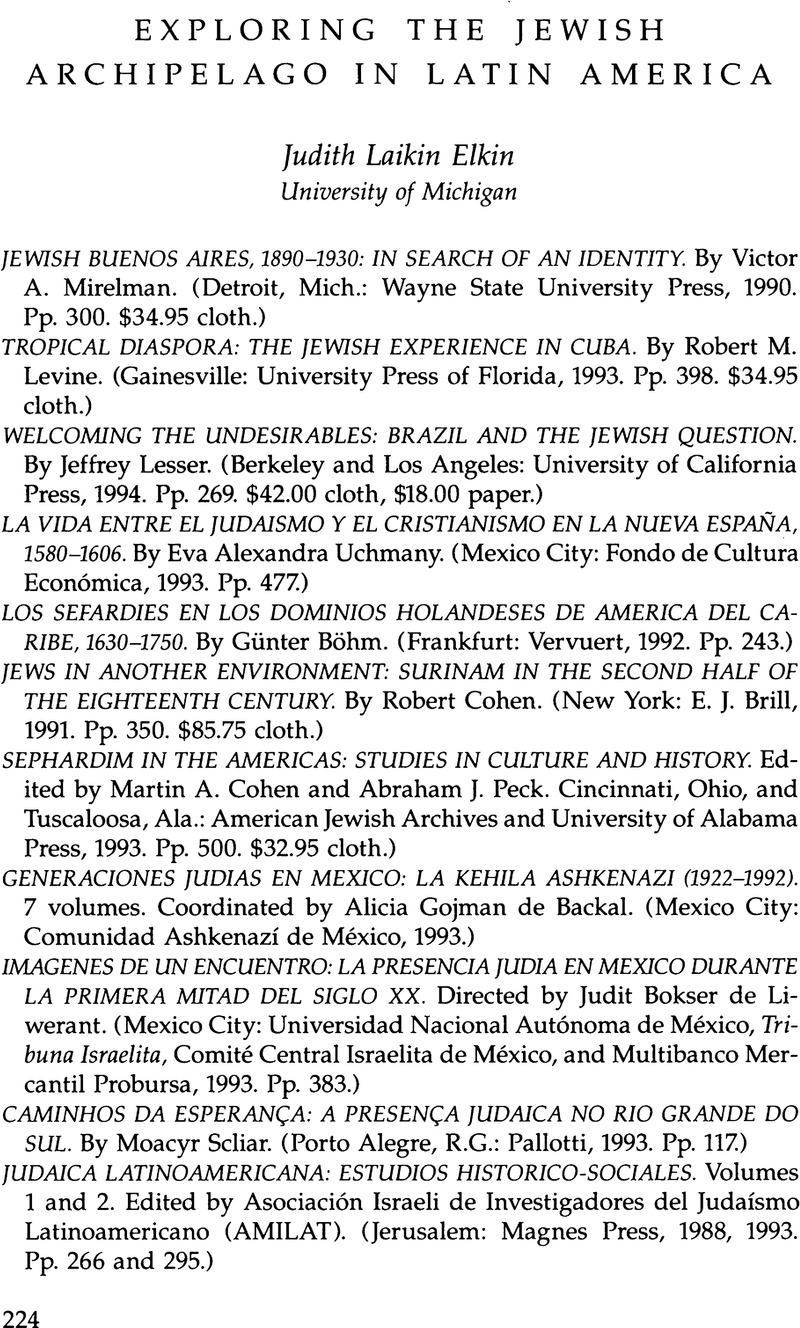Published online by Cambridge University Press: 05 October 2022

1. León Trahtemberg S., La inmigración judía al Perú, 1848–1948 (Lima: Asociación Judía de Beneficencia y Culto, 1987); Jacobo Schifter Sikora, Lowell Gudmundson, and Mario Solera Castro, El judío en Costa Rica (San José, C.R.: Editorial Universidad Estatal a Distancia, 1979); Moshe Nes-El, Historia de la comunidad israelita sefaradí en Chile (Santiago: Nascimento, 1984); Alfredo M. Seiferheld, Inmigración y presencia judías en el Paraguay: Los judíos en el Paraguay (Asunción: Estudios Paraguayos, 1981); Círculo Israelita, Medio siglo de vida judía en La Paz (La Paz: Editorial Aeronáutica de la Fuerza Aérea Boliviana, 1987); and Eugene F. Sofer, From Pale to Pampa: A Social History of the Jews of Buenos Aires (New York: Holmes and Meier, 1982). A book-length bibliography offers citations to these and other relevant titles. See Latin American Jewish Studies: An Annotated Guide to the Literature, compiled by Judith Laikin Elkin and Ana Lya Sater (Westport, Conn.: Greenwood, 1990).
2. The most significant source is Margalit Bejarano, “The Jewish Community of Cuba, 1898–1939: Communal Consolidation and Trends of Integration under the Impact of Changes in World Jewry and Cuban Society,” Ph.D. diss., Hebrew University, Jerusalem, 1992. The thesis is available only in Hebrew, but extracts from it have been published in English and Spanish.
3. Similar service has been provided by Günter Böhm, who transcribed the proceedings of the trial of Francisco Maldonado de Silva in Historia de los judíos en Chile, vol. 1, Período colonial (Santiago: Andrés Bello, 1984); by Clara Cohen de Cohenca, who assembled and transcribed procesos of portugueses in sixteenth-century Asunción in Los marranos en el Paraguay colonial (Asunción: Intercontinental, 1992); and by Anita Novinsky in her numerous articles on the Inquisition and New Christians in Brazil.
4. History of the Jews of the Netherlands Antilles, 2 vols. (Assen, the Netherlands, and Cincinnati, Ohio: Royal van Gorcum and American Jewish Archives, 1970). See also the essays in honor of the 250th anniversary of Mikve Israel-Emanuel Synagogue of Curaçao, which were published in the December 1982 issue of American Jewish History. For the Caribbean as a trading area, consult Stephen Alexander Fortune, Merchants and Jews: The Struggle for British West Indian Commerce, 1650–1750 (Gainesville: University Press of Florida, 1984).
5. For newcomers to the subject, the best introduction to this heavily researched subject is Spain and the Jews: The Sephardi Experience 1492 and After, edited by Elie Kedourie (New York: Thames and Hudson, 1992).
6. A recent study of one such community is Los judíos de Alepo en México (Mexico City: Maguen David, 1989), a project of the Mexican Aleppeno Jewish community coordinated by Liz Hamui de Halabe.
7. Because of their adoption of Latin culture, Ashkenazim who reemigrate to Israel become known there as “Sephardim.”
8. In addition to the titles reviewed here, these works include Testimonios de historia oral: Judíos en México, edited by Alicia Gojman de Backal (Jerusalem: University of Jerusalem, 1990); and a Spanish translation of Corinne A. Krause's 1970 doctoral dissertation, Los judíos en México: Una historia con énfasis especial en el período de 1857 a 1930, translated by Ariela Katz de Gugenheim and published by the Universidad Iberoamericana in Mexico City in 1987. Several ethnographic works have been sponsored by government agencies, including María Eugenia Módena, Pasaporte de culturas: Viaje por la vida de un judío ruso en México (Mexico City: Instituto Nacional de Antropología e Historia, 1982); Guadalupe Zárate Miguel, México y la diáspora judía (Mexico City: Instituto Nacional de Antropología e Historia, 1986); and Luz María Martínez Montiel, La gota de oro (Veracruz: Instituto Veracruzano de Cultura, 1988), which considers Jews among other ethnic groups in Mexico.
9. Perhaps the earliest of these was Pioneros de la Argentina: Los inmigrantes judíos, compiled by a team headed by Manrique Zago (Buenos Aires: Zago, 1982). This study was followed by Integración y marginalidad: Historias de vidas de inmigrantes judíos en la Argentina, edited by a group headed by Sara Itzigsohn (Buenos Aires: Pardes, 1985); see also Vidas en las colonias, a collection of memoirs coordinated and edited by Hélène Gutkowski (Buenos Aires: Contexto, 1991). From Montevideo comes Historias de vida de inmigrantes judíos al Uruguay, compiled and introduced by Teresa Porzecanski (Montevideo: Kehila-Comunidad Israelita del Uruguay, 1986).
10. Published proceedings of LAJSA conferences offer useful essays for Latin Americanists. Collections include The Jewish Presence in Latin America, edited by Judith Laikin Elkin and Gilbert W. Merkx (Boston, Mass.: Allen and Unwin, 1987); Ensayos sobre judaísmo latinoamericano (Buenos Aires: Milá, 1990); and The Jewish Diaspora in Latin America, edited by Lois Baer Barr and David Sheinin (forthcoming). See also Euopäische Juden in Lateinamerika, edited by Achim Schrader and Karl Heinrich Rengstorf (Münster: Röhrig, 1989).
11. The best recent resources are U. O. Schmelz and Sergio DellaPergola, “The Demography of Latin American Jewry,” American Jewish Year Book 85 (1985):51–102; and Sergio DellaPergola and Susana Lerner, La población judía de México: Perfil demográfico, social y cultural (Jerusalem: Hebrew University, 1995).
12. Judith Laikin Elkin, “Latin America's Jews: A Review of Sources,” LARR 20, no. 2 (1985):124–41.